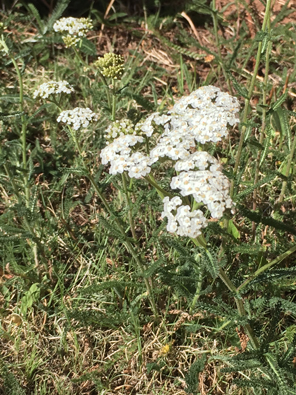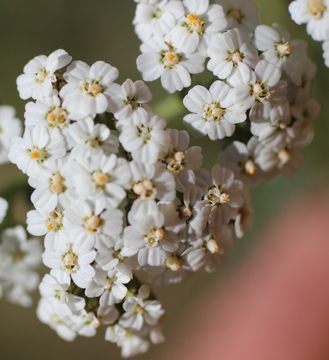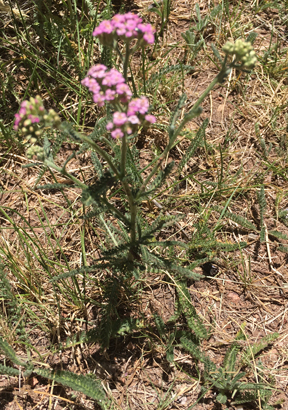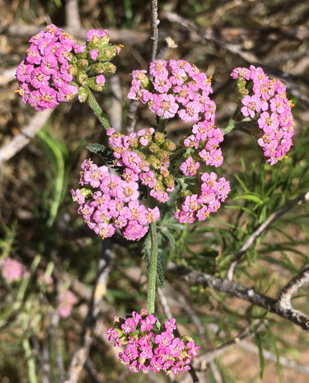
Location
In front and behind Visitor Center (N3D33'02.147 X W105D41'10.469)
Flowers first observed: 5/27/17
The Plant w/Flowers
 |
 |
White variety plant w/flowers |
White variety flowers |
The Flowers
 |
 |
Pink variety plant w/flowers |
Pink variety flowers |
Distribution
"(It) inhabits a wide range of environments, from dry to moist and low to high, from sea level to the Alpine zone of the major mountain ranges; one of the most common wildflowers of the West. Stems are thick and rigid, branching a few times towards the top, each branch topped with a flattish cluster of small white flowers, which have between 3 and 5 ray florets around a center of yellow disc florets (10 to 30). When mature, the petals become pinkish and the center turns brown, though the flowers of some plants are pink throughout the blooming phase. Stems become woody with age." (The American Southwest)
Description
"Western yarrow is a native, herbaceous perennial in the Aster Family. It is a very common wildflower that grows erect from creeping rootstocks, to a height mostly 10 to 36 in. (25 to 90 cm) tall. The leaves of western yarrow are densely hairy, and lacy and fern- like in appearance, as they are finely dissected into numerous, short and narrow divisions not over 0.04 in. (1 mm) wide--millefolium means a thousand leaves in Latin. Common yarrow leaves, in comparison, are smooth or only sparsely hairy; and the leaf segment is longer, more rounded, and lance- shaped. The somewhat rounded terminal clusters of flower heads of western yarrow are normally white to cream-colored and have an extended bloom period from May to September." (USDA)
Ethnobotanical Uses
Food:
"Yarrow has also been used as a food or in teas, and was very popular as a vegetable in the 17th century. The younger leaves are said to be a pleasant leaf vegetablewhen cooked like spinach, or in a soup. Yarrow is sweet with a slight bitter taste. The leaves can also be dried and used as an herb in cooking.
In the Middle Ages, yarrow was part of a herbal mixture known as gruit used in the flavoring of beer prior to the use of hops.[34] The flowers and leaves are used in making some liquors and bitters.[1]" (Wikipedia)
Medicine:
"Most Indian peoples, including the Navajos and certainly the Pueblo tribes, have long known of the medicinal values of yarrow. Various Tewa-speaking Puebloans have chewed on or made a tea from the flowers, leaves, or roots to treat stomach disorders and toothaches. People from Zuni Pueblo know of the cooling effect possessed by the ground leaves of yarrow and have applied them to burns; at San Juan the leaves have been used in this way for sore lips. Other documented medicinal uses include the combating of chills at Cochiti and fever at Picuris and other northern pueblos." (Dunmire and Tierney 222)
"An effective stomach tonic, a tablespoon of the chopped plant in tea, drunk at room temperature. It has a mil(d) laxative effect The tea drunk hot and strong enough to be slightly bitter will stimulate sweat in in dry fevers. Two or three cups a day will decrease menstruation or aid in shrinking mild hemorrhoids and colonic polyps. The fresh leaves are a reasonably effective first aid to stimulate clotting in cuts and abrasions." (Moore 164)
"Yarrow and its North American varieties, was used in traditional Native American herbal medicine by tribes across the continent.[41] The Navajo considered it to be a "life medicine", chewed it for toothaches, and poured an infusion into ears for earaches. The Miwok in California used the plant as an analgesic and head cold remedy.[41]
Several tribes of the Plains Indians used common yarrow. The Pawnee used the stalk for pain relief. The Chippewa used the leaves for headaches by inhaling it in a steam. They also chewed the roots and applied the saliva to their appendages as a stimulant. The Cherokee drank a tea of common yarrow to reduce fever and aid in restful sleep.[41]
Among the Zuni people use the occidentalis variety medicinally. The blossoms and root are chewed, and the juice applied before fire-walking or fire-eating. A poultice of the pulverized plant is mixed with water and applied to burns.[42] Recently it was reported that treatment with Achillea millefolium may attenuate disease severity, inflammatory responses, and demyelinating lesions in a mouse model of Multiple Sclerosis.[43]" (Wikipedia)
Other Uses:
"The dried flower stalks can be used for floral decorations and the straight naked stem, cut to about six inches in length, are used for readings in the I Ching (Book of Changes)." (Moore 164)
Internet Links